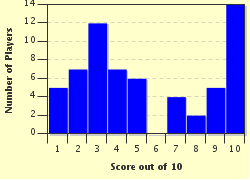Quiz Answer Key and Fun Facts
1. Which French composer wrote a suite entitled "Divertissement", the last movement of which includes blasts on a police whistle?
2. "Orkney Wedding, With Sunrise" by the Lancashire-born composer Sir Peter Maxwell Davies contains a solo part for which instrument traditionally associated with Scotland?
3. The British composer Howard Skempton wrote a piece of music to celebrate the London 2012 Olympics named "Five Rings Triples". Which unusual musical instruments was it composed for?
4. Cowbells play an integral part in the sixth and seventh symphonies of which of the following composers?
5. In which work for young people does Benjamin Britten call for a group of hand-bell ringers?
6. Which of the following "percussion" instruments does NOT play a part in the Symphony No 1 in D minor, "Gothic", by the English composer Havergal Brian?
7. In which work by Malcolm Arnold would you find parts for three vacuum cleaners and a floor polisher?
8. The 1962 piece "Poème symphonique" by György Ligeti is written for 100 of what musical device?
9. In which of these symphonic poems did Richard Strauss make use of a wind machine?
10. The musical work "Branches" contains a part for "amplified cactus", in which the player plucks or flicks the spines to make sounds. What iconoclastic American composer created this work?
Source: Author
stedman
This quiz was reviewed by FunTrivia editor
ralzzz before going online.
Any errors found in FunTrivia content are routinely corrected through our feedback system.


